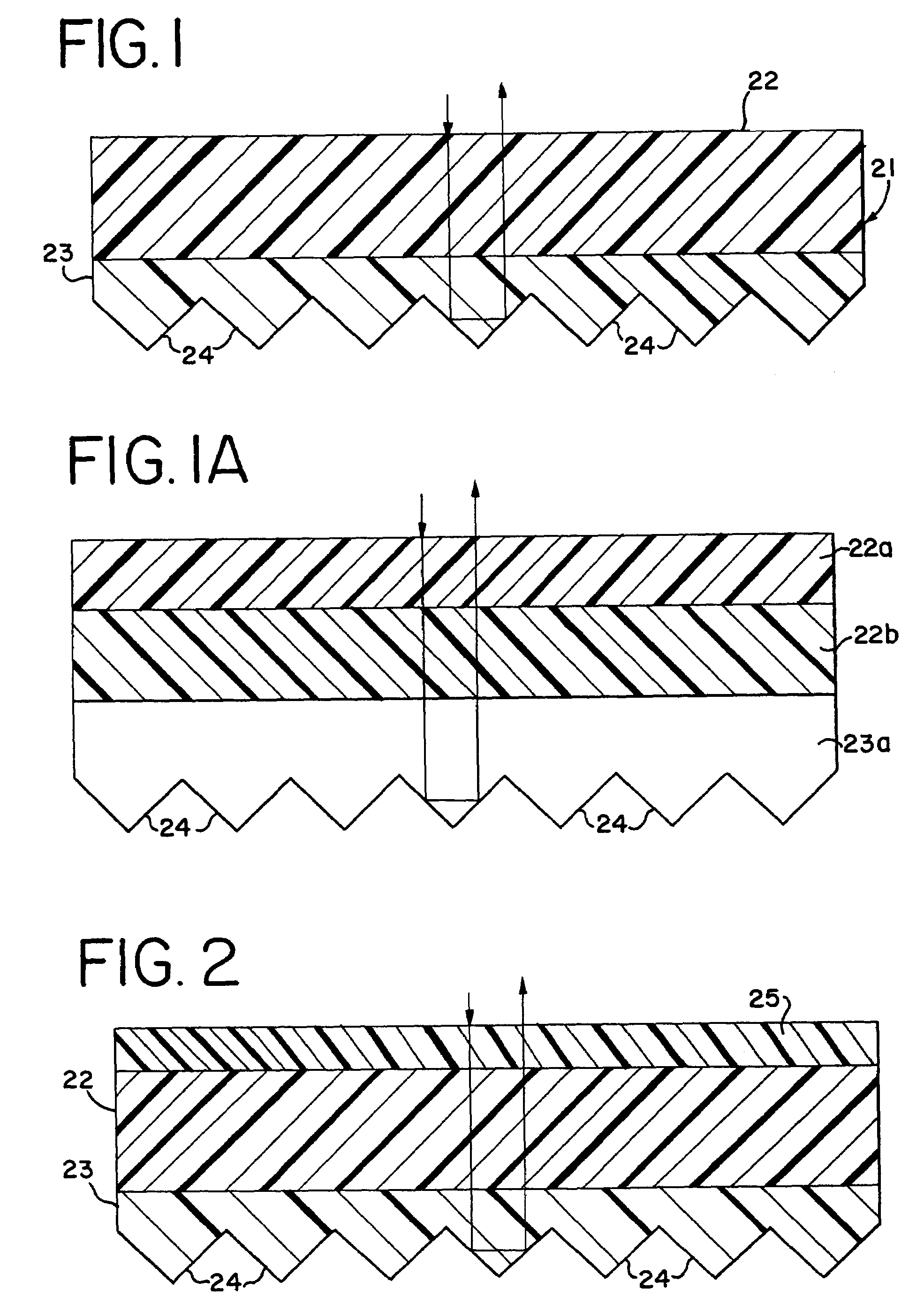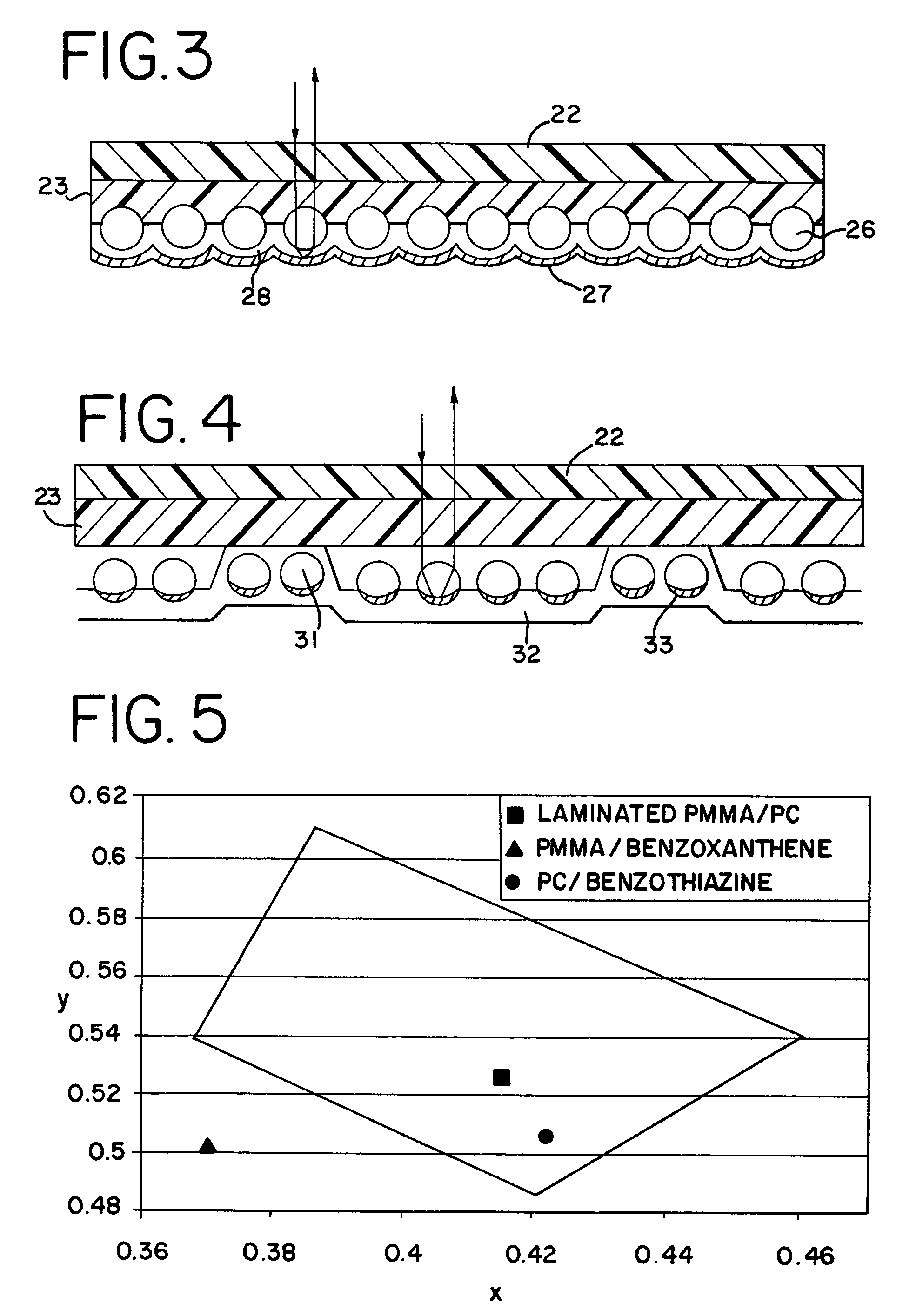Fluorescent articles having multiple film layers
a technology of fluorescent colorants and film layers, which is applied in the field of fluorescent articles with multiple film layers, can solve the problems of major hurdles, poor uv light stability of most fluorescent colorants, and approaches such as these that fail to consider and/or address potential interactions between the uv absorber in the screening layer and the fluorescent dye within the underlying colored layer. to achieve the effect of suitable durability and coloration
- Summary
- Abstract
- Description
- Claims
- Application Information
AI Technical Summary
Benefits of technology
Problems solved by technology
Method used
Image
Examples
example 1
[0090]An overlayer film of a polymethyl methacrylate matrix was prepared by blending an acrylic resin (Acrylite Plus ZK-V-001E, a Cyro trade designation), 0.8 weight percent benzoxanthene fluorescent dye (Lumofast Yellow 3G, a DayGlo trade designation), together with 1.0 weight percent UV absorber (Lowilite 22, a Great Lakes Chemical trade designation), and 0.5 weight percent HALS (Lowilite 62, a Great Lakes Chemical trade designation). This single-layer PMMA was designated Sample 1-1.
[0091]A polycarbonate matrix underlayer film was made by blending polycarbonate resin (Calibre 303EP, a Dow Chemical designation) with 0.06 weight percent benzothiazine fluorescent dye (Huron Yellow D-417, a DayGlo trade designation). This single polycarbonate (PC) film was designated as Sample 1-2-1. Sample 1-2-2 was a multiple film laminate of Sample 1-1 on Sample 1-2-1.
[0092]Another PC underlayer film was prepared from the same polycarbonate resin as sample 1-2-1, together with 0.05 weight percent H...
example 2
[0099]A single layer polymethyl methacrylate film matrix was prepared by combining an acrylic resin, namely Acrylite Plus ZK-V-001E, a trade designation of Cyro, having incorporated thereinto 0.8 weight percent Lumofast Yellow 3G fluorescent dye from DayGlo. This was designated as Sample 2-1. A single polycarbonate matrix film was prepared from Calibre 303EP pellets of Dow Chemical with 0.05 weight percent Huron Yellow D-417 fluorescent dye and 1.5 weight percent Tinuvin 1577 UV absorber. This was designated as Sample 2-2. Sample 2-3 was a two layer PMMA / PC film of Sample 2-1 laminated on Sample 2-2.
[0100]Testing was conducted to determine chromaticity and “Y %” for these three film Samples. These are shown in Table II.
[0101]
TABLE IISampleFilm StructurexyY %2-1Single PMMA film0.37060.503494.152-2Single PC film0.42200.505082.532-3PMMA / PC two layer0.41520.525489.62
[0102]The CIE “x” and “y” color chromaticity coordinates are useful to compare these films with a color standard used and ...
example 3
[0107]The films of Example 2 were converted into retroreflective road sign sheeting through the use of a well-known embossing technique to provide a structure as generally shown in FIG. 1. For this embossing process, a plurality of microprismatic corner cube elements were formed directly into the rear surface of the fluorescent film. Then, a finished retroreflective sheeting was made by bonding a white backing film to the embossed film in a repeating cellular pattern.
[0108]The color coordinates (“x”, “y”) and luminance factor (“Y %”) values of the finished retroreflective sheeting are shown in Table III. For comparison of purposes, the “x”, “y” and “Y %” values of commercial fluorescent yellow green products also are shown. Especially interesting in this regard is the “Y %” value for the two color layer PMMA / PC product. Its “Y %” is higher than either color film which it contains, and it is closer to the commercial products than to the individual films.
[0109]
TABLE IIIRetroreflective...
PUM
| Property | Measurement | Unit |
|---|---|---|
| wavelength range | aaaaa | aaaaa |
| weight percent | aaaaa | aaaaa |
| weight percent | aaaaa | aaaaa |
Abstract
Description
Claims
Application Information
 Login to View More
Login to View More - R&D
- Intellectual Property
- Life Sciences
- Materials
- Tech Scout
- Unparalleled Data Quality
- Higher Quality Content
- 60% Fewer Hallucinations
Browse by: Latest US Patents, China's latest patents, Technical Efficacy Thesaurus, Application Domain, Technology Topic, Popular Technical Reports.
© 2025 PatSnap. All rights reserved.Legal|Privacy policy|Modern Slavery Act Transparency Statement|Sitemap|About US| Contact US: help@patsnap.com



